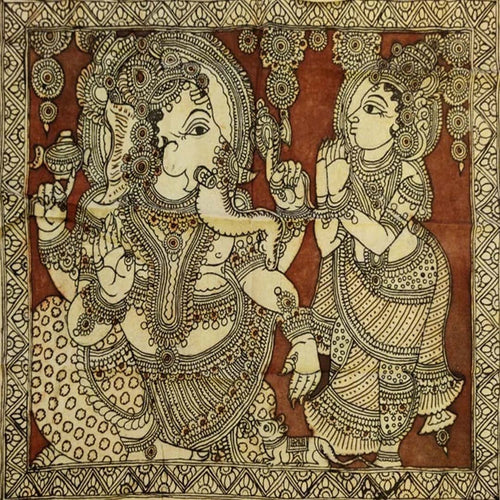

About Kalamkari
Kalamkari is an Indian art form that involves painting or printing on fabric using natural dyes and intricate penwork. In fact, the name "Kalamkari" literally means ‘craftwork done with a pen’. It flourished during the Mughal period and later under the patronage of the Golconda and Coromandel (parts of Andhra Pradesh and Tamil Nadu) Sultanates in South India. The most prominent centers of Kalamkari today are Srikalahasti (Chittoor District) and Machilipatnam (Krishna District) in Andhra Pradesh. The traditional themes depicted in this art form are the episodes of Hindu mythological epics like Mahabharata and Ramayana—the depiction of deities like Ganesha, Rama, Krishna, and Arjuna and common occurrences. Additionally, the rounded face, long big eyes, and detailing of costume and jewelry are all important features of Kalamkari art.
Tradition and Legend
One of the most fascinating aspects of Kalamkari is its deep-rooted connection to mythology and folklore. According to legend, this art form originated when Lord Krishna's divine consort, Radha, taught the art of Kalamkari to the women of the ancient village of Machilipatnam in Andhra Pradesh. Since then, Kalamkari has been passed down through generations, with each artisan adding their unique touch to the tradition. In addition, there is one more popular legend that says, Kalamkari was used to paint the image of Hanuman on the flag of Arjuna's chariot for the Kurukshetra war.
Technique and Method
Kalamkari involves a meticulous process that begins with preparing the canvas, usually cotton or silk fabric. Artisans then outline the design using a bamboo or palm stick dipped in fermented jaggery and water solution, known as "kalam," which acts as a natural mordant. Once the outlines are drawn, the fabric is treated with natural dyes extracted from plants, roots, and minerals, such as indigo, madder, and myrobalam to fill in the intricate patterns. The entire process is intricate and time-consuming, requiring immense skill and precision. Harinath N, Sudheerji, and Siva Reddy are some of the master artists practicing the art of Kalamkari.
FAQs
How do I authenticate genuine Kalamkari art?
Authentic Kalamkari art can be identified by its intricate hand-drawn or block-printed designs, use of natural dyes, and traditional patterns. Genuine Kalamkari products often have slight imperfections that add to their uniqueness.
What is the significance of motifs used in Kalamkari designs?
Kalamkari designs often feature motifs inspired by nature, mythology, and folklore. Common motifs include peacocks, flowers, trees, and scenes from epics like the Ramayana and Mahabharata. Each motif carries cultural and symbolic significance, reflecting the rich heritage and storytelling tradition of Kalamkari art.
Are Kalamkari products suitable for gifting?
Yes, Kalamkari products make excellent gifts due to their unique artistry and cultural significance. They are perfect for special occasions such as birthdays, anniversaries, and festive celebrations.
What are the benefits of using natural dyes in Kalamkari art?
Natural dyes used in Kalamkari art have several benefits. They are eco-friendly, reducing environmental impact. Additionally, natural dyes produce rich, vibrant colors that age gracefully over time, giving the products a unique and enduring beauty.
Highlights of Kalamkari Artform
| Artform | Kalamkari |
|---|---|
| Origin | |
| Materials Used | |
| Colours Used | |
| Popular Themes | |
| Price Range | |
| Artists | |
| Making Process | Handmade |








